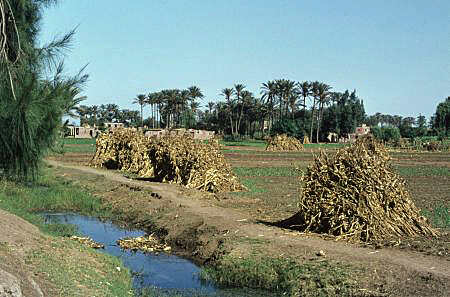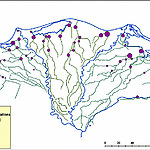The oldest land reclamation, however, was upstream of the Delta along the Nile. It concerned the works to protect against high water that were already realized around 3400 BC (before Christ) during the reign of King Menes. In his time, the new capital Memphis was built in an old fertile riverbed, for which a dam was built in the Nile about 20 kilometres south of Memphis. The course of the Nile was diverted to a canal that was dug between two hills. The dam, about 450 meters long, would have been maximum 15 metres high.
At a later stage, King Menes dug a lake northwest of the new city and built a canal to connect it to the Nile. The system of lake, canal and river served as a moat to protect him from his enemies. The dam was carefully maintained and guarded, because if it had been breached, Memphis would have been flooded. When the Greek historian Herodotus visited Egypt some 2,500 years later, the dam was still being carefully maintained.
In the Ptolematic and Roman periods - around 300 BC to 450 - lowland areas in the north of the Nile Delta were reclaimed, which might also have involved land reclamation.
The first mention of a polder in the true sense of the word was the reclamation in 1887 of almost the entire lake of Abu Qir, in the north of the Nile Delta on the coast of the Mediterranean Sea. The first pumping station for drainage is said to have been built in 1898 in the El-Max area near Alexandria to drain the excess water from approximately 89,000 hectares.
For millennia irrigation by means of sprinkler irrigation has been the most important method of irrigation in Egypt. From 1826 onwards, a system of canals was constructed in the Nile Delta for this purpose. Later, a series of dams were built at the apex of the Nile Delta and in various branches of the Nile. In addition, at the beginning of the 20th century, the Aswan Dam was built on the Nile in the south of Egypt and has been raised several times since then.
In the northern extremities of the Nile Delta, there used to be mainly lowland areas with lakes and swamps. The reclaimed area was about 25,000 hectares. Drainage began shortly after the introduction of year-round irrigation in the 19th century and has increased since then. The drainage canals that were built at that time drained the water under gravity. However, the flat nature of the delta made it necessary to build pumping stations in some places. At present, some parts of the Nile Delta are even five metres below sea level.
At the end of the 19th century and the beginning of the 20th century, private companies reclaimed land in the Nile Delta. The total area from 1932 to 1952 was approximately 84,000 hectares. After the revolution of 1952, the Egyptian government became more involved in land reclamation. Priority was given to improving the situation of the rural poor and to distributing the reclaimed lands to small farmers and landless groups, while certain reclaimed areas remained under the administration of the State. The Ministry of Land Reform and Reclamation carried out such reclamations with varying degrees of success until 1967, based on five-year plans. After the war of 1967, this development was slowed down by budget cuts. In the 1980s, the government distributed the reclaimed lands to new university graduates, who each received between 1.7 and 2.1 hectares.
However, most of the agricultural lands in the northern part of the Nile Delta have been developed relatively recently. Most of these areas were developed based on Soviet-style State or collective farms. Large pumping stations were built to irrigate large areas. However, this development was abandoned in the 1970s, after which the farms were divided into various forms of land ownership. In the 1980s, part of the land was offered to potential developers. They had to form a cooperative of at least 100 people to which a large piece of land was sold and each of them was allocated a plot of about 30 hectares.
With the raising of the Aswan High Dam, 85% of Egypt's agricultural land became cultivable under year-round irrigation. The conversion of the remaining land was achieved after the inauguration of the Aswan High Dam in 1970. The construction and adaptation of a complex network of canals in the Nile Delta allowed for the extension of agriculture to the coastal zone and for year-round irrigation. These infrastructural interventions changed the Nile's regime from a seasonal flow to a much more constant and controlled flow with negligible sediment load.
The northern edge of the Nile Delta is now partly 1 to 2 metres below sea level. Dikes have been built to protect these low-lying areas against flooding from the sea and from the branches of the Nile. The Nile Delta now contains many polders, with a total area of 1.14 million hectares. For drainage purposes, the delta is divided into 70 sub-areas. The excess water from the low-lying polders is pumped up 1 to 3 metres from the drainage canals into main drainage canals. The main drainage canals carry the water either as a free outflow, via a pumping station to one of the four lakes near the Mediterranean Sea, or directly to the sea. The main drainage canals also receive water under gravity from upstream higher areas in the South. In 1988, there were 70 pumping stations in the Nile Delta with a total capacity of 1,300 cubic metres per second, which corresponds to an average discharge capacity of 8 millimetres per day calculated over the polder area.
Some examples of polders in the Nile Delta are:
- Mansour and Zawia polders (27,300 hectares). These polders were reclaimed in the 1960s in the eastern part of Lake Burullus. Agriculture still suffers from high salinity. The lake itself was separated from the agricultural lands by flooded marshes during high flows, which have now been drained. Lake Burullus itself is one of Egypt’s most important wetlands and the second largest lake. However, most of the water it receives is intensively used and reused water from agricultural fields, fish farms and municipal waste water. In short, this populated coastal zone forms a transition between high-production agriculture and fish farms with the lake area. This presents a number of water quantity, water quality and environmental issues and complexities;
- Mariut Lake (26,000 hectares). Due to a 3-metre drop in the water level, large parts of the lake dried up. A dike was built, a pumping station installed and 10,000 hectares of land in the lake were reclaimed;
- 1,600 hectare polder in Lake Idku;
- 100 hectare trial polder near the western shore of Lake Manzala.


